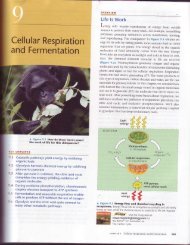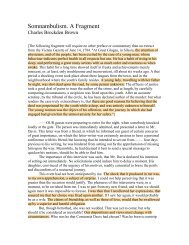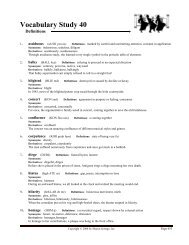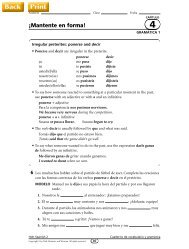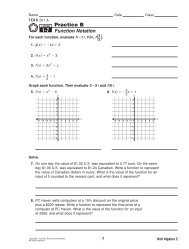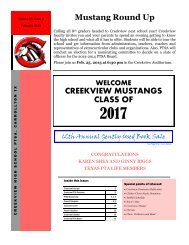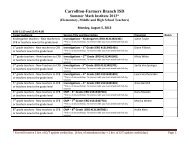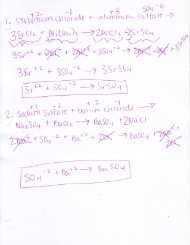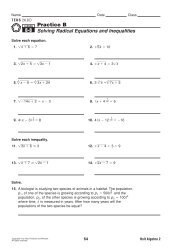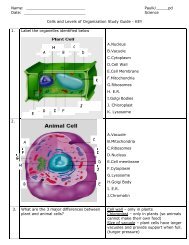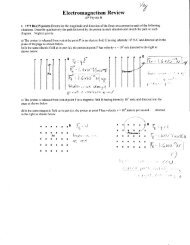Pt Two
Pt Two
Pt Two
You also want an ePaper? Increase the reach of your titles
YUMPU automatically turns print PDFs into web optimized ePapers that Google loves.
UNIT NINE: Late Baroque and Rococo STUDY GUIDE<br />
W Joseph Wright of Derby. An Experiment with an Air Pump, 1768, oil on canvas<br />
Joseph Wright of Derby/ the bird in the glass bowl/ moonlight and the Enlightenment/ a questioning gesture<br />
from the scientist/ a reflective pose of the philosopher/ two sisters torn between curiosity and distress/<br />
appearance of well-dressed lovers<br />
1. “One of the earliest practitioners of a Romantic mode in Britain was Joseph<br />
Wright of Derby (1734-1797), who had trained as a portrait painter with Thomas<br />
Hudson, Reynolds‟s teacher. After Wright‟s Grand Tour of 1773-1775, he returned<br />
to the Midlands to paint its local society. Many of those he painted were the selfmade<br />
entrepreneurs of the first wave of the Industrial Revolution, which was a<br />
member of the Lunar Society, a group of industrialists (including Wedgewood),<br />
mercantilists, and progressive nobles who met in Derby. As part of the society‟s<br />
attempts to popularize science, Wright painted a series of „entertaining‟ scenes of<br />
scientific experiments, including An Experiment on a Bird in the Air-Pump”<br />
(Stokstad, Art History 949-50). “The air pump was one of the most innovative<br />
scientific developments of the eighteenth century. Although it was employed<br />
primarily to study the property of gases, it was also widely used to promote the<br />
public‟s interest in science because of its dramatic possibilities. In the experiment<br />
shown here, air was pumped out of the large glass bowl until the small creature<br />
inside, a bird, collapsed from lack of oxygen; before the animal died, air was<br />
reintroduced by a simple mechanism at the top of the bowl. In front of an<br />
audience of adults and children, a lecturer is shown on the verge of reintroducing<br />
air into the glass receiver. Near the window at right, a boy stands ready to lower a cage when the bird revives. (The moon visible out the<br />
window is a reference to the Lunar Society.) By delaying the reintroduction of air, the scientist has created considerable suspense, as the<br />
reactions of the two girls indicate. Their father, a voice of reason, attempts to dispel their fears. The dramatic lighting not only<br />
underscores the life-and-death issue of the bird‟s fate but also suggests the fact that science brings light into a world of darkness and<br />
ignorance. The lighting adds a religious dimension as well” (950).<br />
2. “The moon is probably a reference to the Lunar Society. Based in the English Midlands, the birthplace of the Industrial Revolution, it<br />
met each month to discuss recent scientific developments and conduct experiments. Many of Wright‟s friends and patrons were members<br />
of the Society. It epitomizes, like Wright‟s painting, the spirit and exchange of ideas that are the essence of the Enlightenment (the Age of<br />
Reason). The Society met during the full moon so that its members would have the convenience of riding home by the light of the moon-<br />
hence the Society‟s name” (Cumming, Annotated Art 69). “The visiting scientist has flowing locks and a long robe, which make him look<br />
rather like a wizard. It was common practice at the time for a scientist to travel to a private residence to provide an evening‟s<br />
entertainment and instruction to a wealthy family” (68).<br />
3. “Born in Derby, near the site of England‟s first large manufactory, Joseph Wright became the first painter of the Industrial Revolution,<br />
a portraitist and friend of manufacturers, engineers and those early scientists who were still called „natural philosophers‟. Trained in<br />
London by Thomas Hudson, teacher of Wright‟s older contemporary Reynolds, he, like Reynolds, desired to be more than an „ordinary‟<br />
craftsman. In the enquiring spirit of Derby acquaintances, and emulating the Dutch followers of Caravaggio- „candlelight‟ masters such<br />
as Honthorst and Godfired Schalcken who had worked at the English court- Wright turned to ceaseless pictorial experiments in the effects<br />
of light, notably in nocturnal views of industrial scenes- blacksmiths‟ shops, iron forges, glass-blowing houses, blast furnaces, cotton<br />
mills- and of volcanic eruptions, which he depicted repeatedly after witnessing Vesuvius in action during a visit to Italy in 1773-5. All were<br />
painted with a new, Romantic fervour, in which, like the scientist and poet Dr. Erasmus Darwin, grandfather of Charles, Wright was able<br />
to „Inlist Imagination under the banner of Science‟” (Langmuir 329). “Darwin‟s tag fittingly describes this large painting, at once modern<br />
genre, „history painting‟, vanitas and portrait. It depicts not so much an experiment as a science-based home entertainment of the kind<br />
which Josiah Wedgewood was to arrange in 1779, when he summoned an assistant of the chemist Joseph Priestley to instruct his<br />
children and his friends. In Wright‟s picture a charismatic natural philosopher demonstrates the effects of a vacuum and the necessity of<br />
air for living creatures. The air has been pumped out of the flask at the top of the large apparatus on the table with the air pump,<br />
invented by the German physicist Otto von Guericke in about 1650. Another of his inventions, a pair of Magdeburg spheres, is lying<br />
nearby; when they are placed together, the air pumped out from between them, the resultant vacuum makes the spheres inseparable. In<br />
the flask a valuable white cockatoo is struggling for air and appears near to death. Only the scientist- white-haired and direct of gaze and<br />
gesture like God the Father in religious imagery- can save it by releasing the valve at the top of the flask” (329-330).<br />
4. “The boy at the window lowers the bird‟s cage in hope of its imminent release; his two sisters react with grief and horror to their pet‟s<br />
agony, as their father adduces the chilly comforts of reason. The elderly man on the right meditates on death- a theme whose universal<br />
application is made even plainer by the human skull preserved in the large glass, from behind which shines a single candle. Another<br />
traditional motif of transience is introduced in the watch in which the man on the left times the demonstration. Behind his a boy watches<br />
with fascination. The youthful couple are alone in ignoring the central action, their eyes locked in love, their thoughts only of life. They<br />
are Mary Barlow and Thomas Coltman, who were to marry in 1769; their double portrait as a married couple, painted by Wright in 1771,<br />
is also in the [National] Gallery” in London (330). “A fainter secondary source of light is the moon outside the window- a Gothick touch<br />
reminding us that in the late eighteenth century science and the occult were sometimes confused, and equally enthralling. In a few years,<br />
Dr. Mesmer would demonstrate „animal magnetism‟ in Paris, while in England Erasmus Darwin‟s Lunar Society would meet every Monday<br />
nearest the full moon to discuss advances in science and technology” (330).<br />
32



